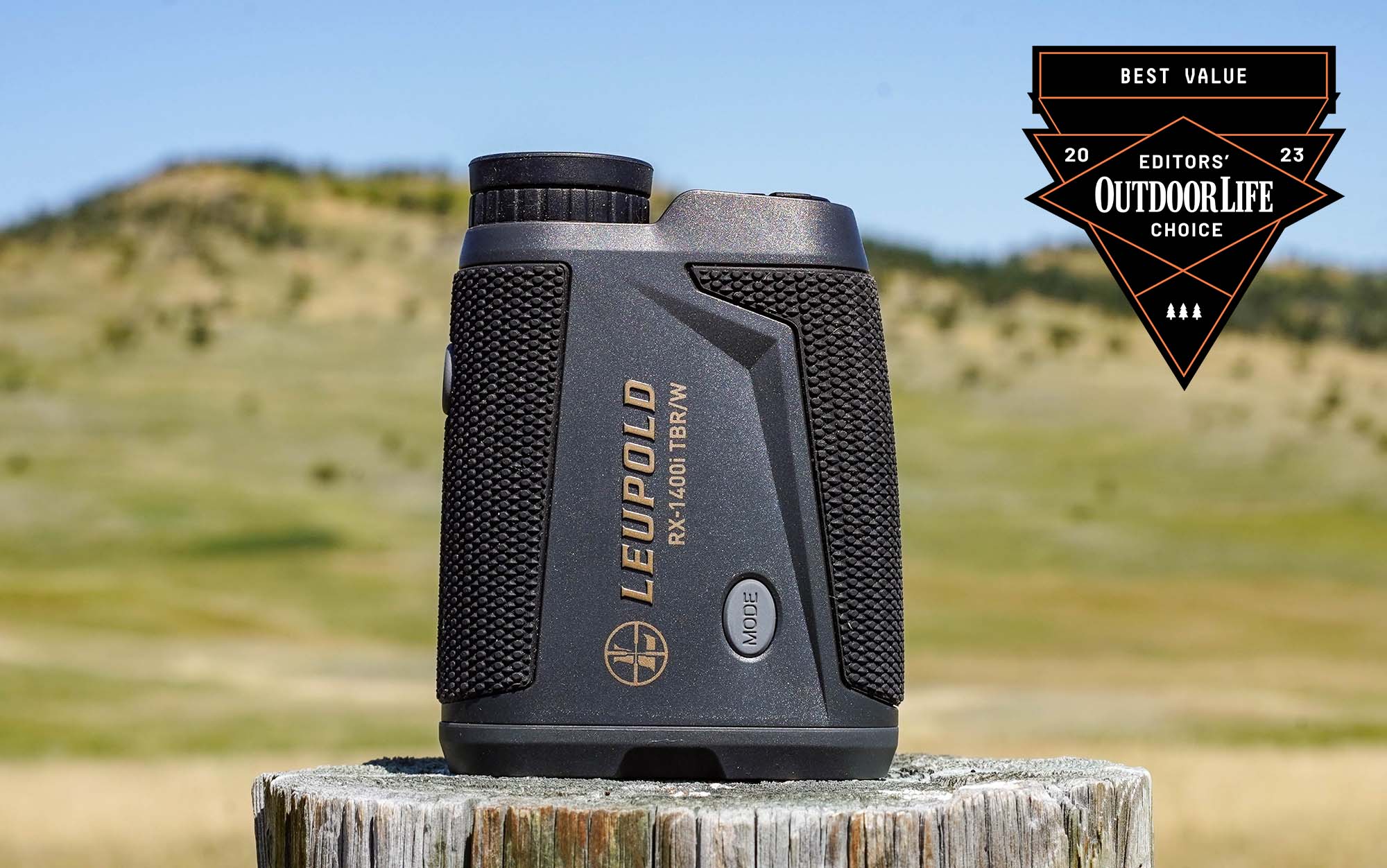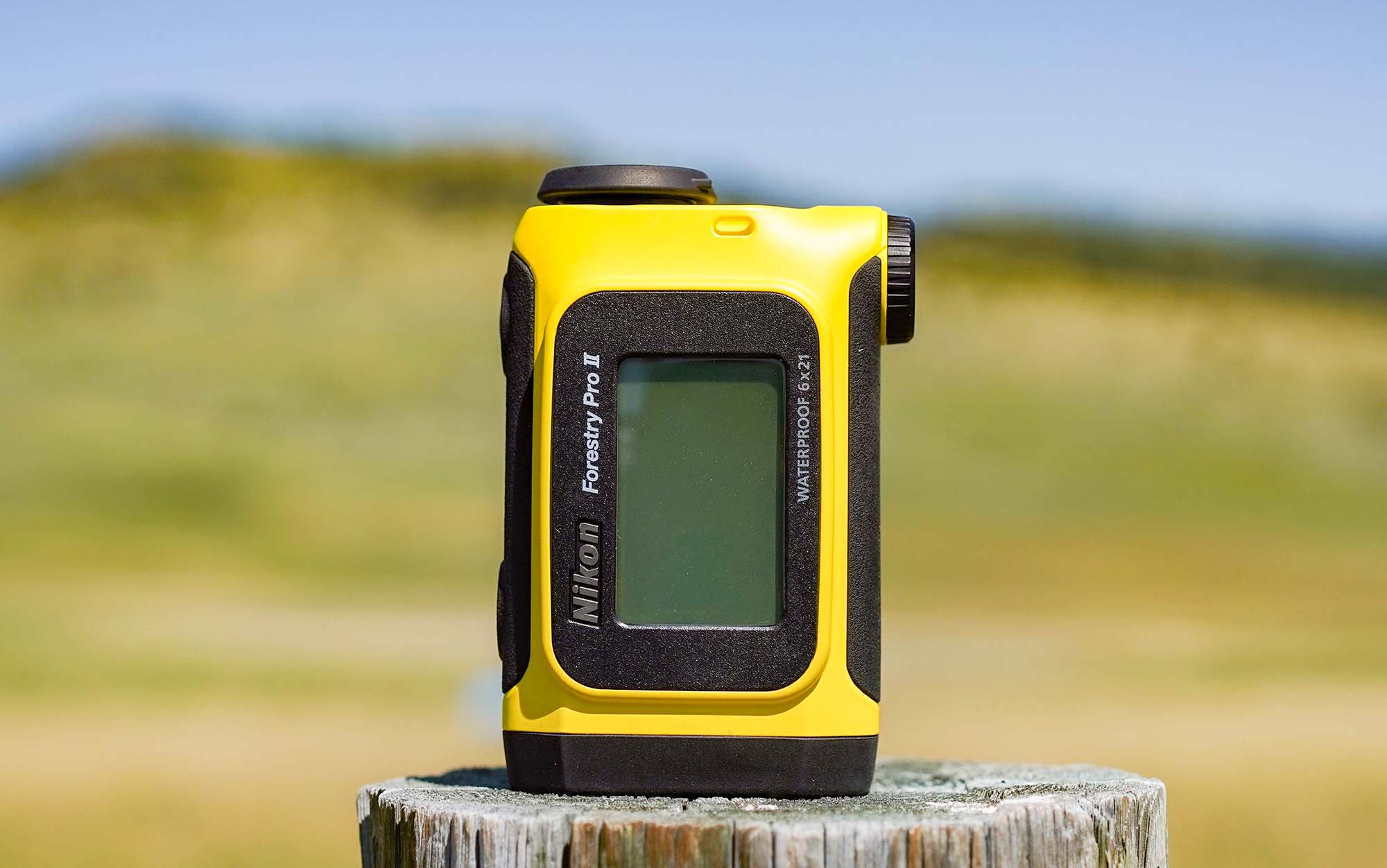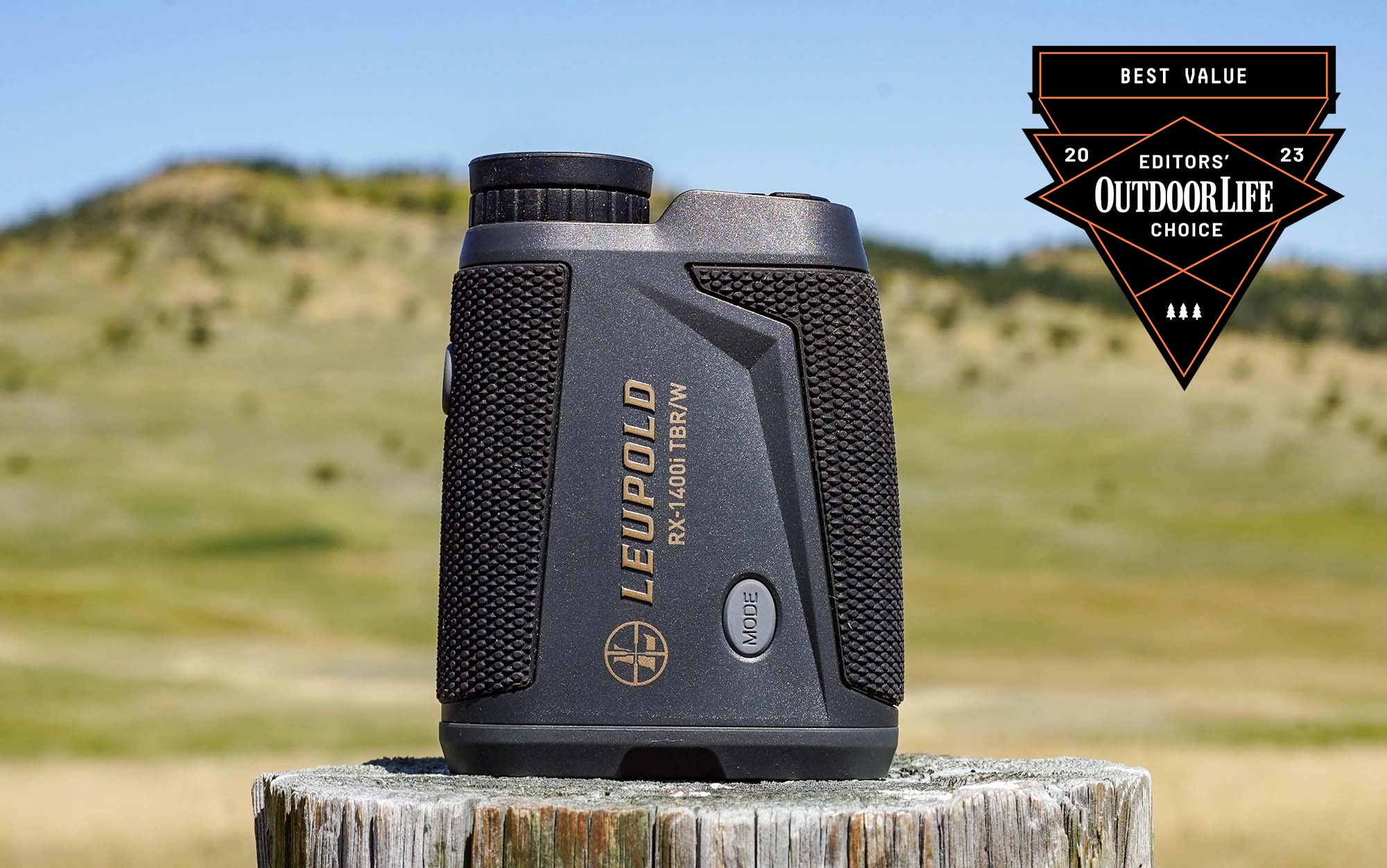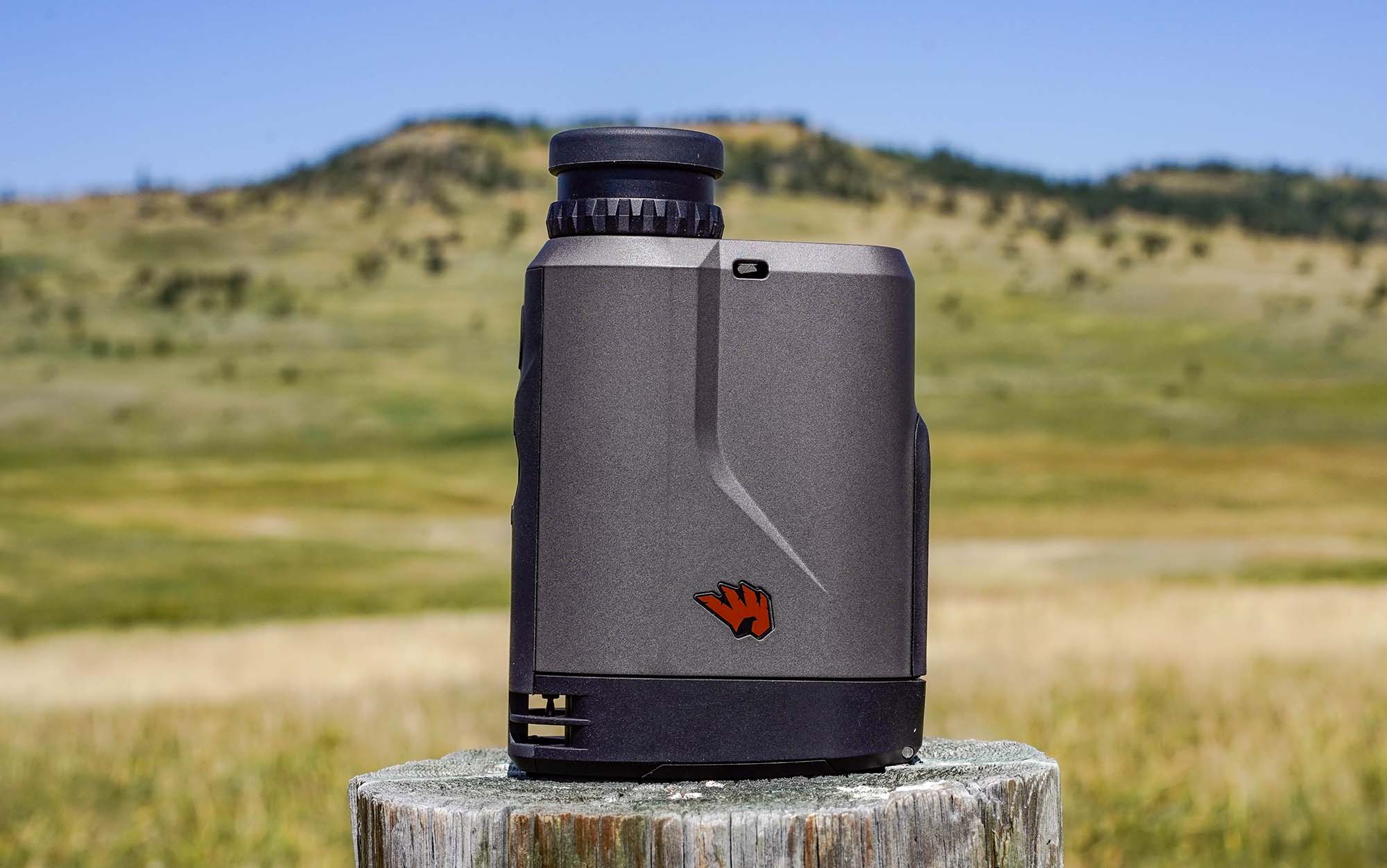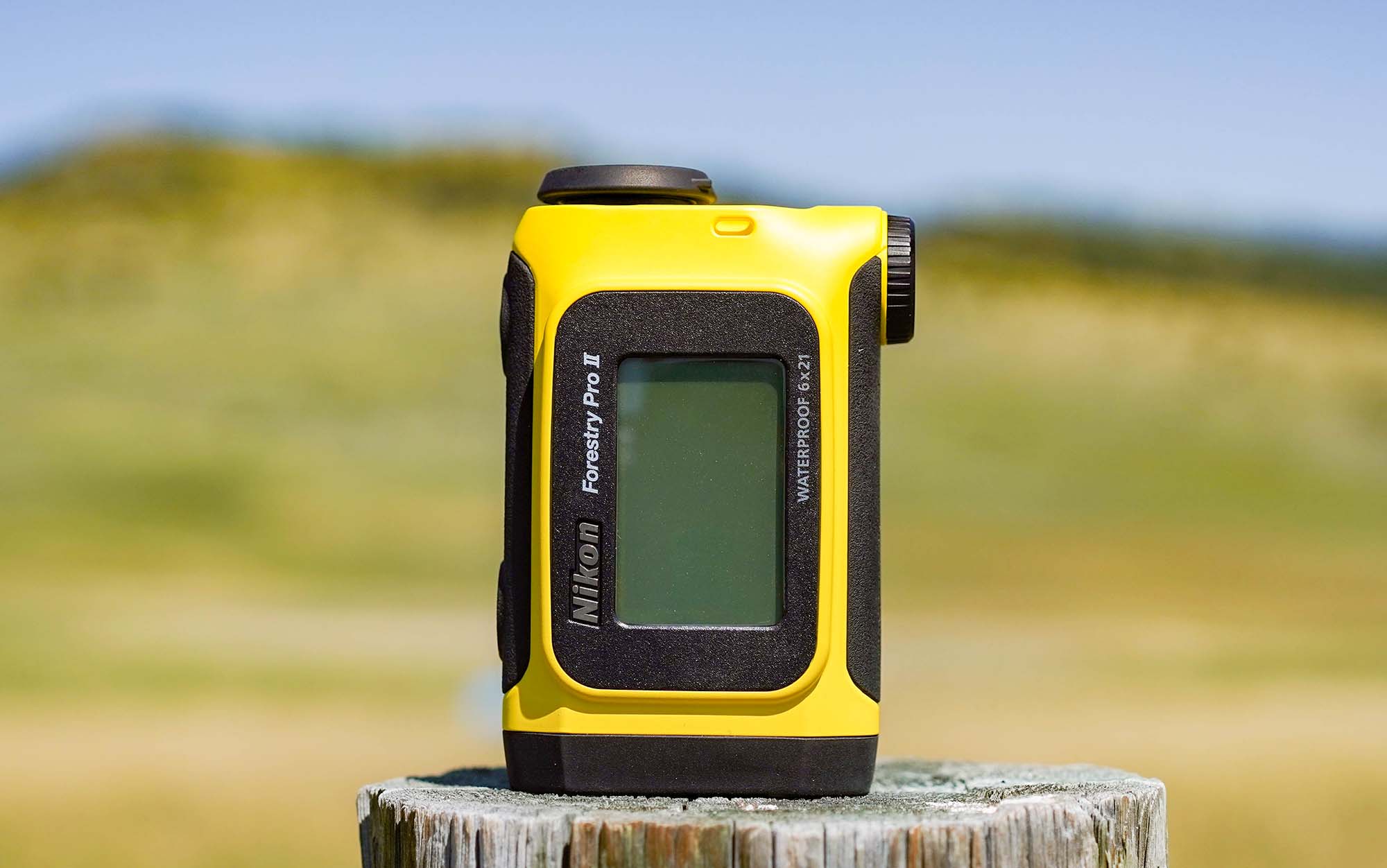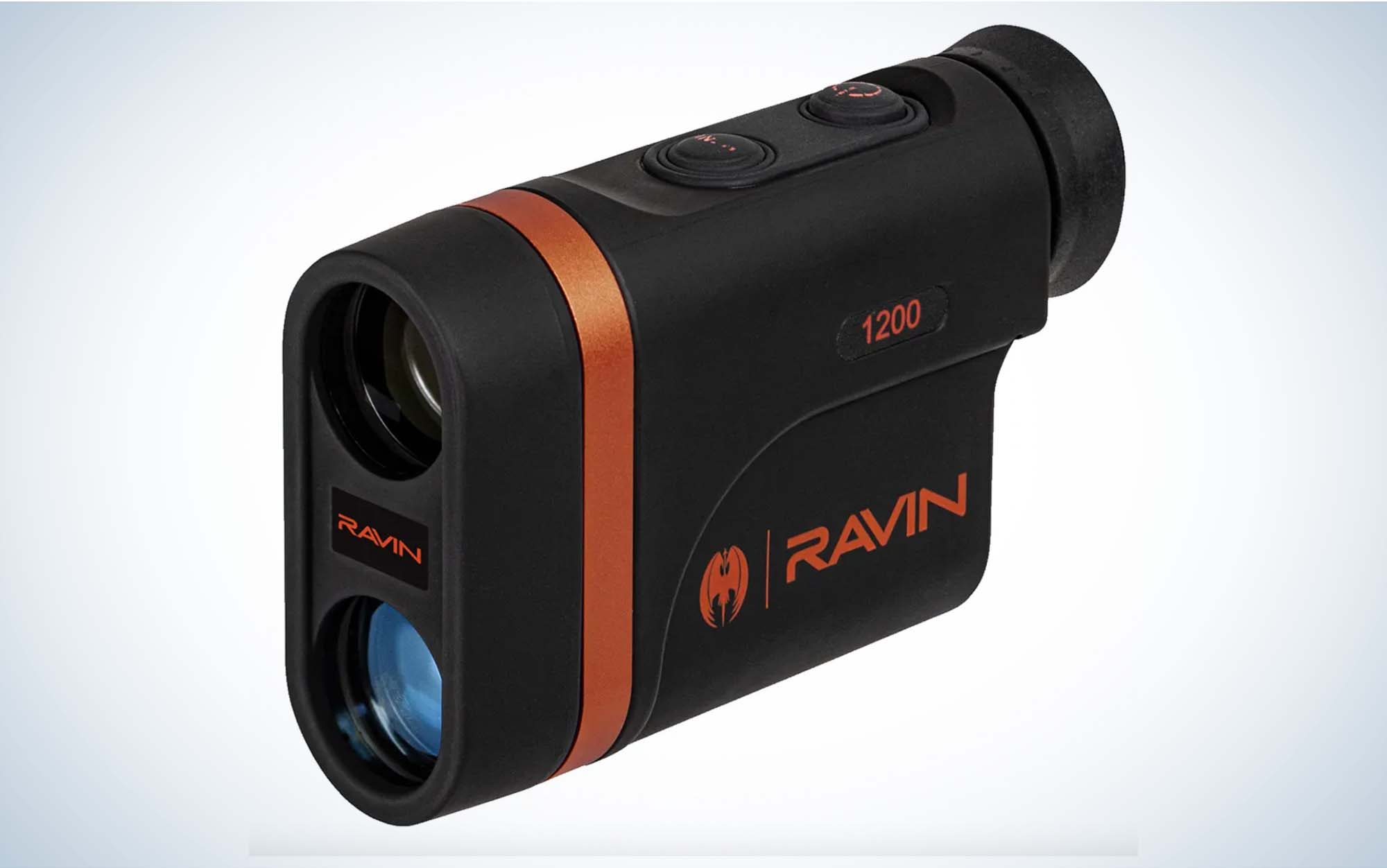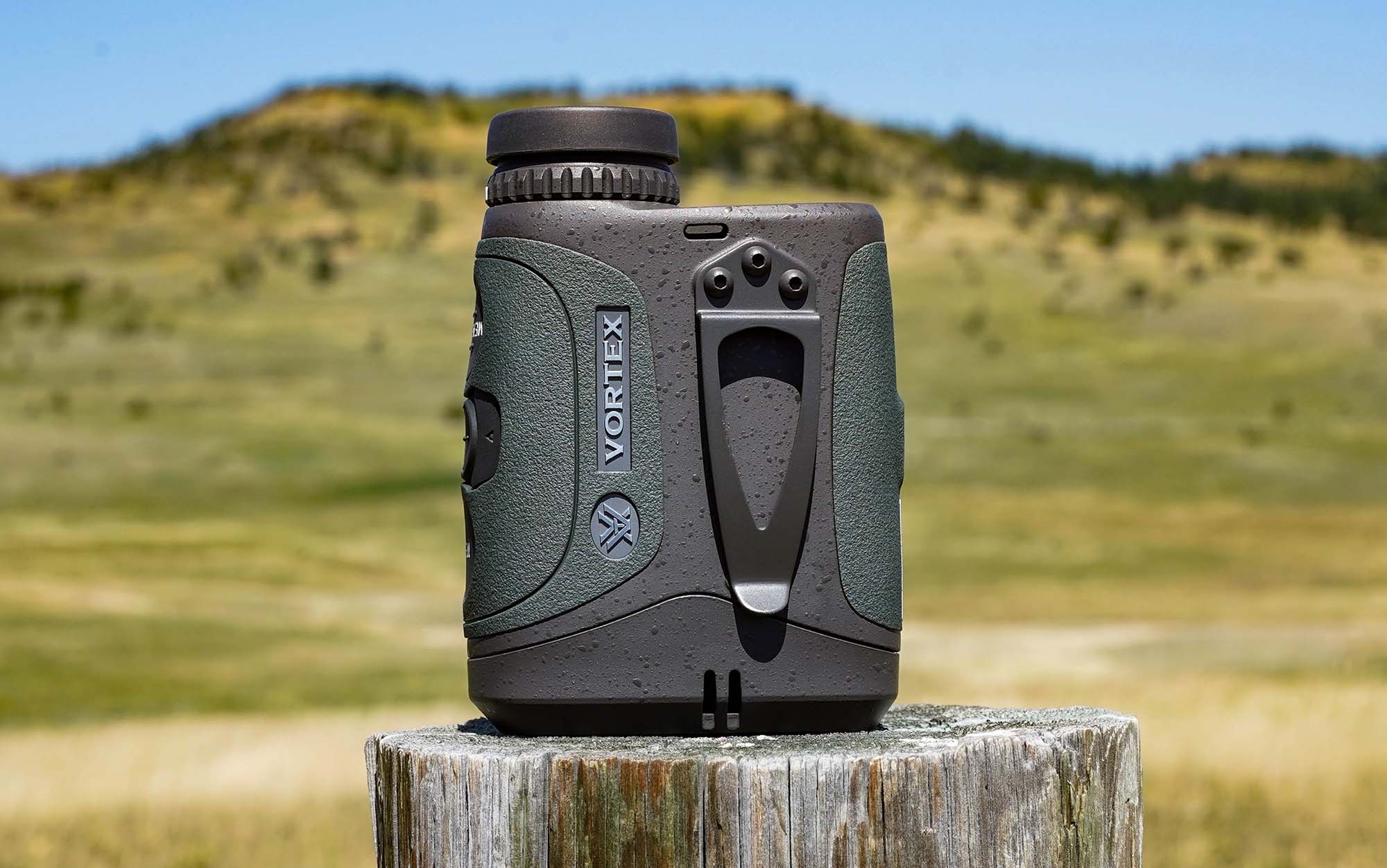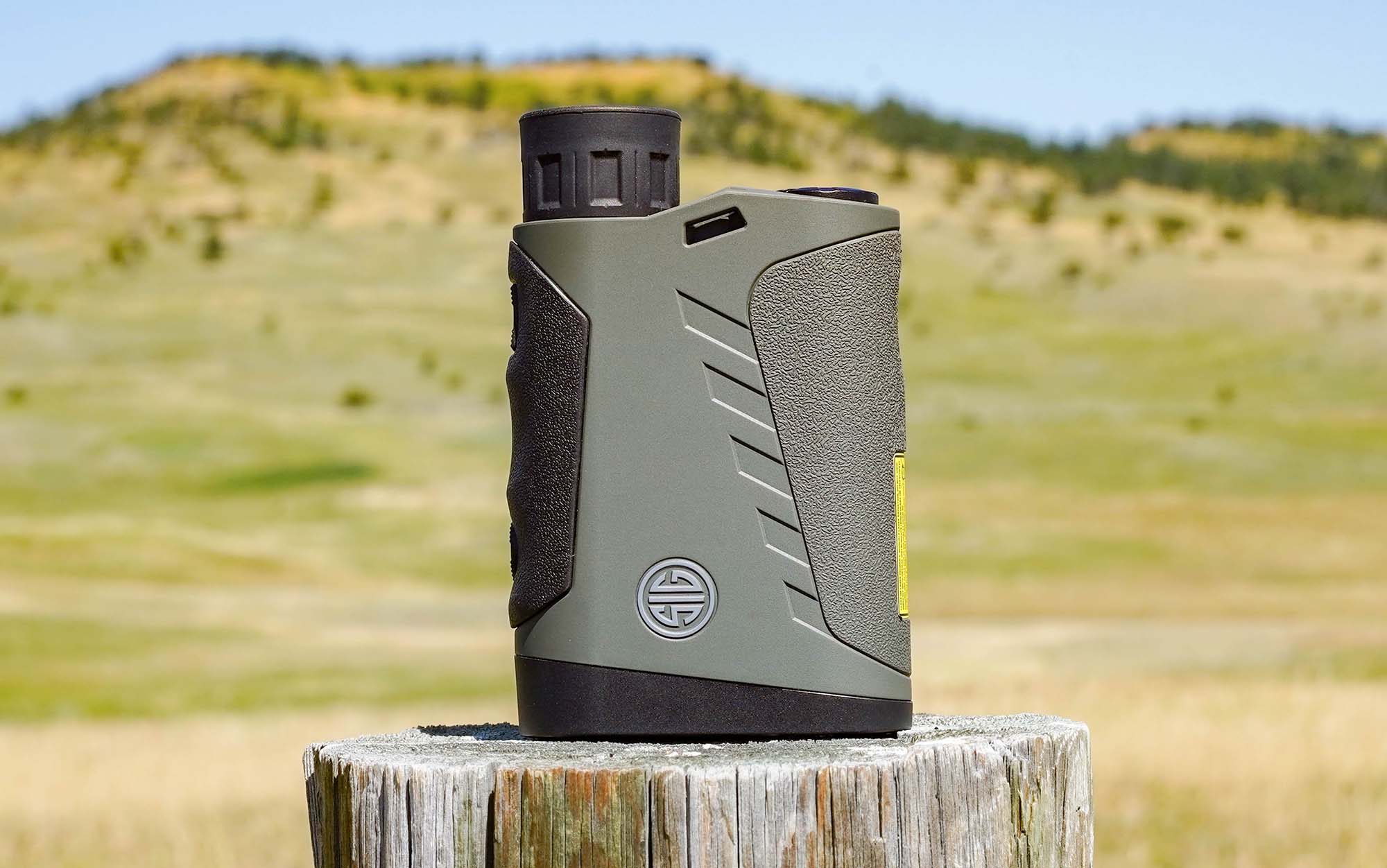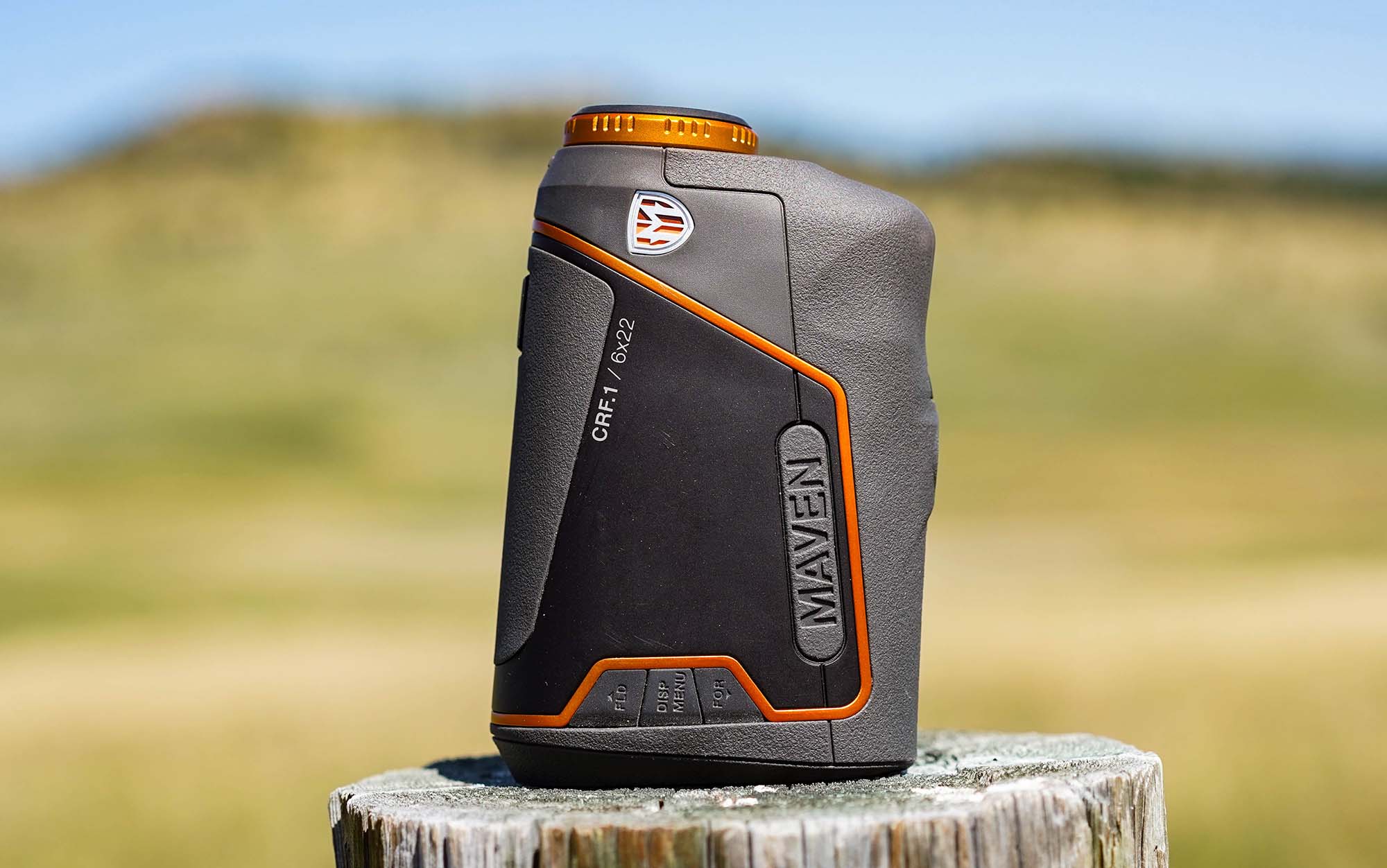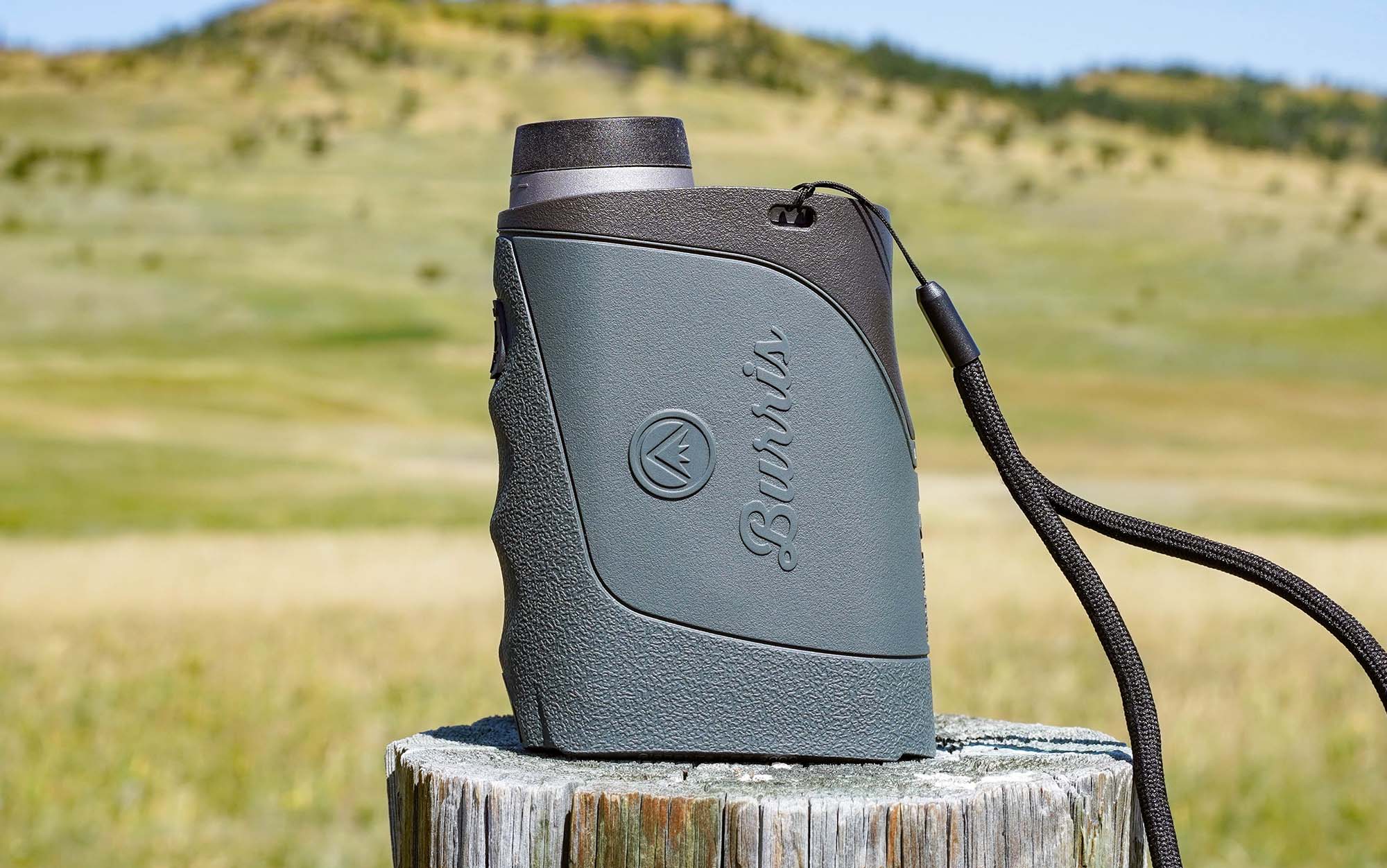The Best Rangefinders for Hunting of 2023
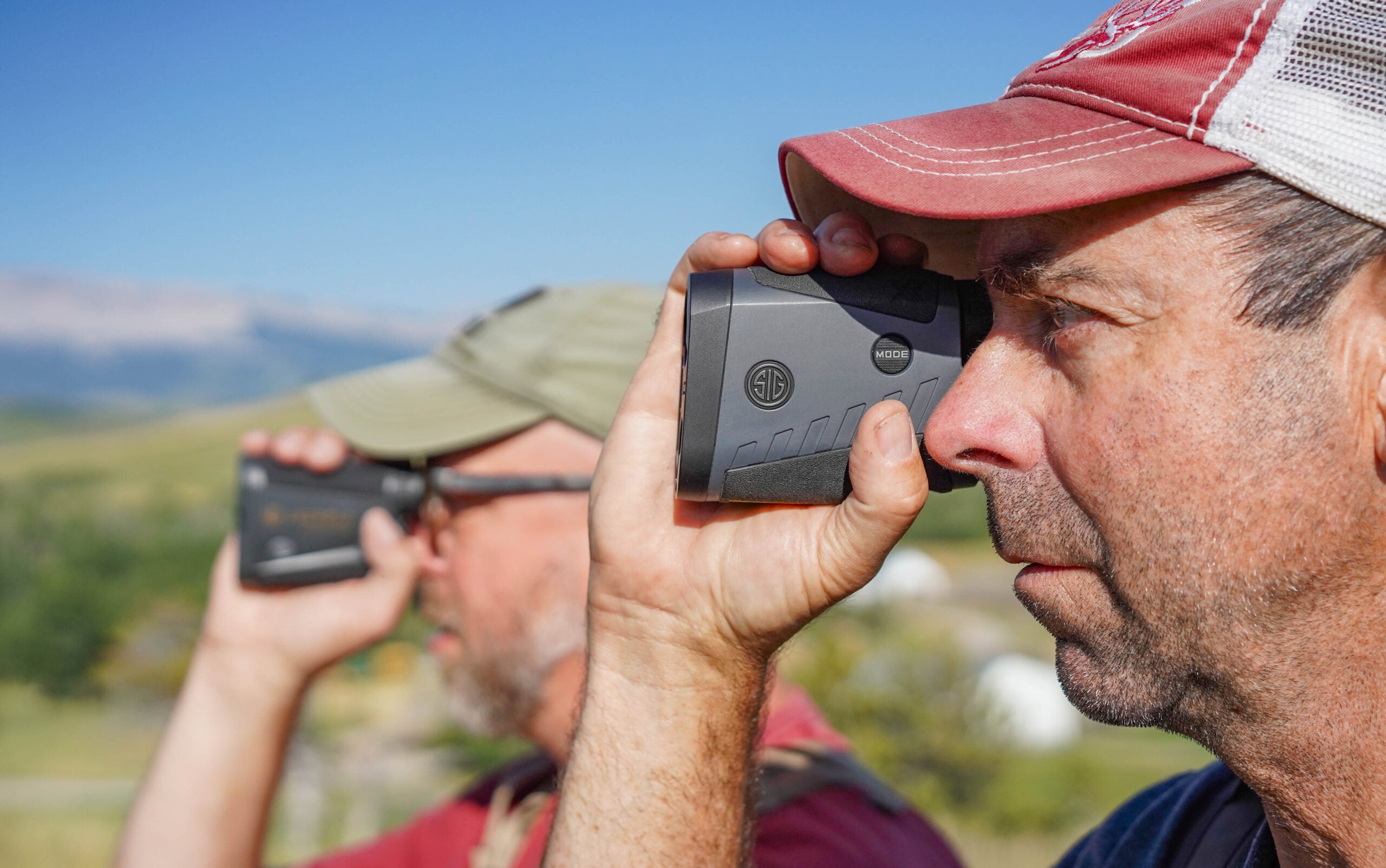
We may earn revenue from the products available on this page and participate in affiliate programs. Learn More ›
Most of us judge a laser rangefinder by its obvious attributes. When we peer through the lens and press the ranging button, does it deliver an accurate and consistent distance to the target. Done and done.
But a few curious members of our community navigate the mode commands, and learn that their range-u-lator can also measure incline, temperature, elevation, and altitude and apply a prodigious amount of ballistic calculation to make us more lethal hunters.
Ours is a test of these multidimensional monoculars, those that carry ballistic software, ranging reticles, and even Bluetooth connectivity. Because not every hunter and shooter needs or wants that capability, we include a few point-and-shoot units fully worth your attention. This year’s field was among the most exciting we’ve seen with both high value and the latest technology. Here are our picks for best rangefinders for hunting from our 2023 optics test.
- Best Overall: Sig Sauer KILO4K
- Great Buy: Leupold RX-1400i TBR/W Gen2
- Best for Long-Range Shooting: Revic BR4
- Best for Treestand Hunting: Nikon Forestry Pro II
- Best Crossbow Rangefinder: Ravin 1200
- Vortex Razor HD 4000 GB
- Sig Sauer KILO3K
- Maven CRF.1
- Burris Signature LRF 2000
How We Tested the Best Rangefinders
Manufacturers’ ranging claims are as spurious as a camouflage company’s promise to elude. Most take their best distances, not their average, and discount target size and orientation. They don’t always report what we found, some inconsistent ranging on a wide variety of surfaces, from gravel to grass to 3D archery targets to trees. We test the maximum and minimum range, and use every targeting mode and menu option. We’ve provided the max and minimum ranges we were able to achieve on non-reflective targets to give you an idea of real-world capabilities.
We mount monoculars on tripods to get rock-solid ranging, and we take the units in the field, deploying them both methodically and rapidly at targets of various sizes and distances. And then we pair them to a slave rifle and a ballistic app and judge their ability to improve our shooting accuracy.
We break our 10-point scoring into four general categories: ranging performance, display and optics, features, and value. The average of these categories is the basis of our grades, detailed below.
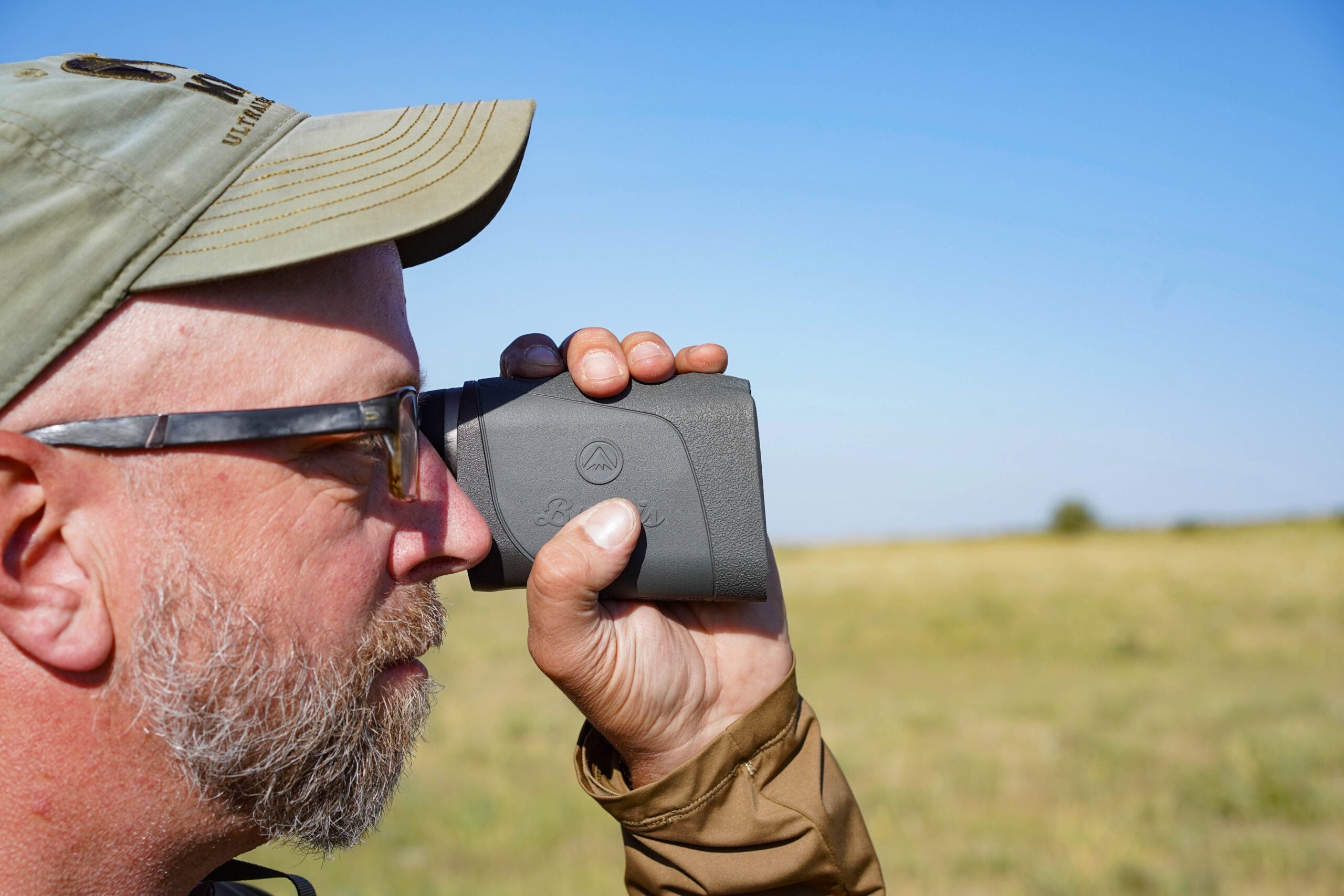
Ranging performance includes both the maximum and minimum distances the unit is capable of ranging, but also ranging precision and ability to repeatedly range objects of various sizes and textures. The performance score also considers various targeting modes. Display and optics assesses how well the unit “sees” targets, how useful and adjustable the display is to each users’ eyesight and different light conditions, and reticle utility. The feature grade assesses whether the unit connects to a mobile app, or contains a ballistic library, or has on-board sensors. Lastly, our value grade is a measure of whether the unit is worth its price, and considers its peer group, warranty, and amenities like a lanyard or carrying case.
The laser rangefinder that gets the highest overall score wins our Editor’s Choice award for the best in the category; the optic with the highest price/value score wins our Great Buy recognition. We also assigned other awards for specific noteworthy attributes.
How We Grade Optics
Our 10-point evaluation adds up to a total numeric score, but we translate those to grades for each submission. Our Ranging Performance grade combines the scores from ranging, accuracy, sensitivity, and processor speed. Our Display/Optics grade aggregates both display and optics scores. The Features grade considers amenities, connectivity, and versatility. And then the Price/Value grade is our assessment of whether a rangefinder is worth the money, which also considers durability.
To earn an “Excellent” grade, the average of that category must be 9 or higher, which is extremely hard to achieve. “Very Good” is an average score of 7 to 9. A “Good” grade is 5 to 7. Our “Fair” grade is 3 to 5, and “Poor” is anything under 3.
Best Rangefinders for Hunting: Reviews & Recommendations
Best Overall: Sig Sauer KILO4K
Score Card
- Ranging Performance: Very Good
- Display/Optics: Excellent
- Features: Excellent
- Price/Value: Good
Key Features
- 4,000-yard stated range
- Communicates with BDX-enabled sights and devices
- Image stabilization
- 6x22mm
- Aiming solutions powered by Applied Ballistics Ultralite
- Ultra-fast ranging engine
- Five target modes: first, best, last, fog, extended range
Pros
- Stabilization settles image
- Connects to BaseMap app for dropping waypoints
- Archery mode
- Fastest ranging engine in the test
- Circle plus milling grid reticles
- Tripod mountable
- 5.3-yard minimum range
Cons
- At test venue, maximum range of 2,500 yards
- Jinky connection to BaseMap app
- Addition of stabilization makes this a spendy unit
Students of our optics test may recall Nikon’s CoolShot laser rangefinder with an image stabilization feature borrowed from Nikon’s camera-lens technology. Though the product was mainly geared to golfers, we found such utility in hunting—locking in on distant targets and getting a legitimate range when buck fever is delaminating your nerves—that we were bummed when Nikon discontinued the product last year.
We have fresh reason to recommend the technology. Sig Sauer has added image stabilization to its excellent KILO4K, and it elevates an already wonderful hand-held LRF into a next-level hunting and shooting tool. One-hand users (bowhunters, long-range rifle spotters) will especially utilize the stabilization feature.
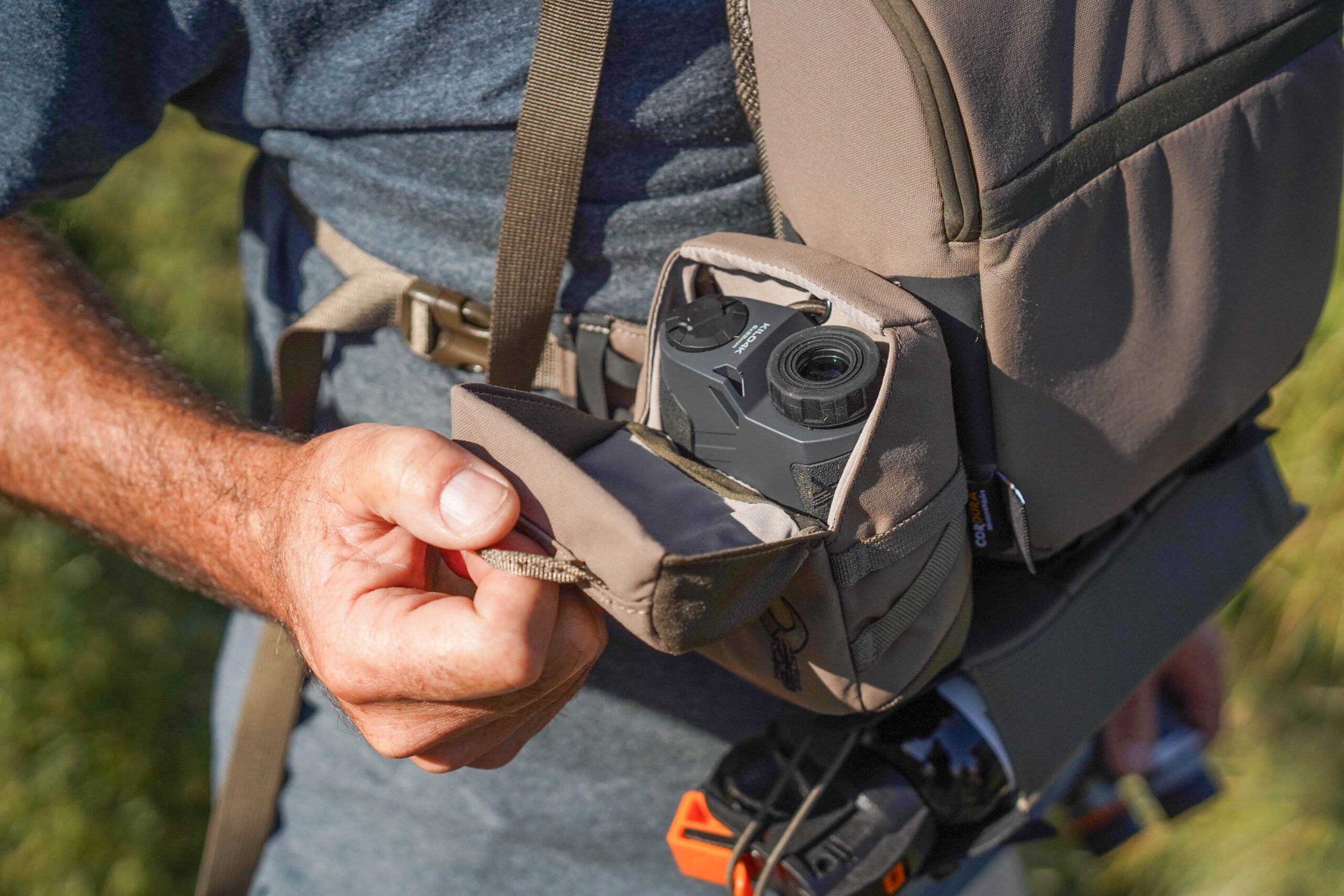
The basics of the KILO4K are shared by Sig’s other (and excellent) higher-end rangefinders. It has Bluetooth connectivity to allow users to access features from the BDX mobile app, which links the rangefinder to BDX-enabled rifle scopes and “smart” binoculars. The KILO4K is pre-loaded with Applied Ballistics Ultralite, which provides precise ballistics solutions out to 875 yards, but users can pair the KILO4K with an external wind and environmental sensor, and through the app, get long-range firing solutions from Applied Ballistics Elite. For shooters who want just the basics, the unit also has eight ballistics groups that users can match to their caliber and load.
The Sig has five ranging modes: BDX-U, BDX-X, angle-modified range (AMR), line-of-sight ranging, and an archery mode. And it has five target modes: first, best, last, fog, and extended range. Combined with a selectable reticle, very good optical glass and coatings, and the fastest ranging engine of our test, this is a powerful, versatile monocular.
We struggled to get readings out to 4,000 meters, as the unit promises. Our best range at our test venue was just inside 2,500 yards, and testers noted that the Sig struggled on non-reflective targets.
“At 1,000 yards, I ranged the gravel road, but couldn’t get a reading on the grass next to it,” noted Scott Einsmann, OL’s gear editor. We noted that inside about 1,200 yards, readings were consistent, but beyond that distance they became sporadic, with testers employing the hunt-and-peck approach of ranging every object around their target in order to get a close-enough reading.
But every tester noted that the image stabilization compensates for iffy readings.
“Stabilization is insane and I could hit an IPSC target at 550 yards handheld,” says Einsmann. “This is the one LRF [in our test] I would buy for hunting.”
As we discovered with Sig’s image-stabilized ZULU6 binocular, image quality can be improved dramatically by removing the shakes and tremors introduced by the hand. The tradeoff is that the non-stabilized image is typically not quite as good as optics that don’t build the shake-settling gyroscope into their products. We also noted that, between the stabilization feature, Bluetooth connectivity, and the full spectrum of software running the KILO4K, battery life is an issue. Make sure you bring backup batteries.
And make sure you bring your checkbook. The image-stabilized 4K is about $260 more than Sig’s very good, but pedestrian in comparison, KILO3K. The main difference is the addition of stabilization in the 4K model, plus a few more bells and whistles and ranging capacity. Our testers reckoned that the stabilization feature is worth that, and more, and given the KILO4K’s wide and deep versatility, made it our consensus pick for the best rangefinder.
Great Buy: Leupold RX-1400i TBR/W Gen2
Score Card
- Ranging Performance: Good
- Display/Optics: Very Good
- Features: Good
- Price/Value: Excellent
Key Features
- 6-1,400-yard range
- 5x21mm
- Bow and rifle modes
- Three selectable reticles
- Uses Leupold’s ballistic software (TBR/W)
- Uses Flightpath software for bowhunters
- Red TOLED display
Pros
- Extremely accessible price
- Users can pick from 25 ballistics groups
- Wind, line-of-sight, and last-target modes
- Aiming solution in MOA, MIL, or holdover
- Very lightweight (6 ounces)
Cons
- Utility is limited to about 1,000 yards
- No connectivity to mobile app
- Not tripod mountable
Despite spending an intensive week with this rangefinder, our test team can’t figure out how Leupold has packed so much technology and capability in a rangefinder that retails for under $200.
If you’re a bowhunter, this is an LRF to consider. In BOW mode, the Leupold uses its proprietary True Ballistics Range engine to derive angle-adjusted ranges, but it limits outputs to 175 yards. In return for the limited range, archers get more precise ranging than the unit delivers at its farthest limits. The 1400i also features Flightpath, which shows archers the height of their arrow’s path at a determined middle distance to their target. It’s a smart feature that can help bowhunters avoid hitting obstructions.
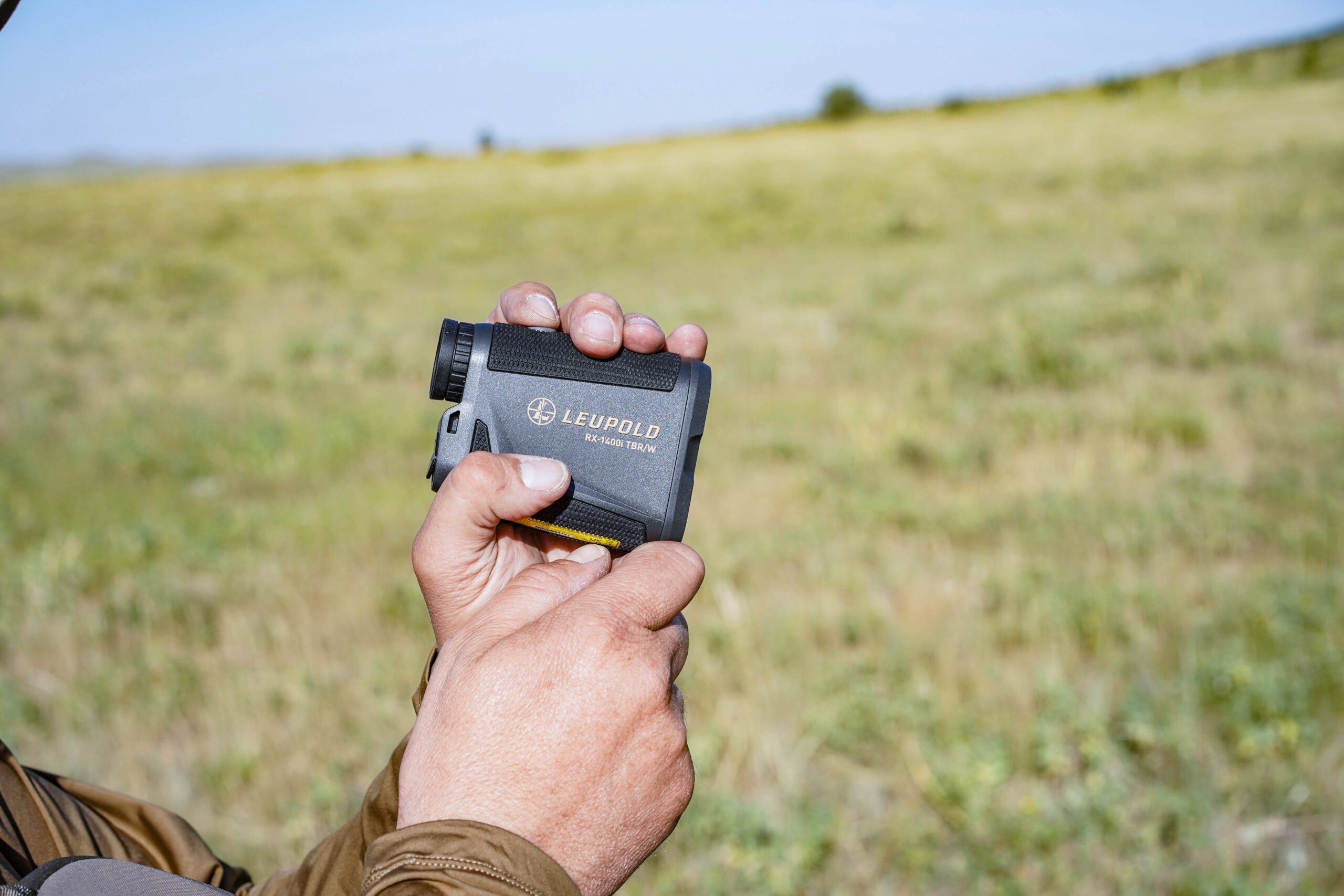
If you’re a rifle hunter, the Leupold not only uses the company’s well-traveled TBR engine, but it provides distance-informed wind holds for a 10 mph crosswind. The unit displays holdover in either MOA, MILs, inches, or centimeters. Because the 1400i doesn’t connect to a smartphone app or other ballistics library, it relies on the bullet-drop characteristics of 25 ballistic families of calibers and bullet weights. It’s not quite as precise as a custom ballistic profile, but it’s certainly quicker and easier than connecting via Bluetooth. It also helps explain the appealing price point—under $200—of the Leupold.
Other appealing attributes include three selectable reticles: circle, circle-plex, and plex. We got close-in ranges to 6 yards, and the distance readings were right on par with stated performance. Our best range was 1,485 yards on grass.
“This is a great choice for the multi-season hunter who isn’t shooting past about 500 yards with a rifle, which is most of us,” noted Einsmann.
Testers were less impressed with the TOLED display, which pops nicely against low-contrast backgrounds but which testers noted is clear only with the eye squarely in the eyebox. If you’re off just a bit, the display blurs distractedly.
But those are admittedly thin critiques for a solid, serviceable, and extremely affordable rangefinder, one that I used myself during archery elk season in Montana this fall. By packing a ton of talent in a light, capable unit Leupold was our consensus pick for our Great Buy award.
Read Next: Best Rangefinders for Bowhunting
Best for Long-Range Shooting: Revic BR4
Score Card
- Ranging Performance: Very Good
- Display/Optics: Good
- Features: Good
- Price/Value: Good
Key Features
- 4,000-yard stated range
- Bluetooth connection to Revic Opps app
- Rugged metallic chassis
- 10x25mm
- Firing solutions in MOA, MIL, and BDC-based “Shoot to Range”
- Innovative dual-lens cover
- Tripod mountable
Pros
- Programmable horizontal base wind values
- Extremely easy connectivity to ballistic app
- ER (extreme range) mode useful beyond 300 yards
- Configured for use with Gunwerks long-distance shooting system
- Nice ballistic nylon case
- Very fast ranging engine
Cons
- 10-power monocular limits close use
- Relatively short battery life
- No auto-adjust for display brightness
- Hard to focus both display and image
A powerful and versatile rangefinder, the BR4 is optimized for long-range shooting. The second-generation rangefinder from the optics arm of Gunwerks, the custom long-range rifle maker based in Cody, Wyoming, the BR4 is about 30 percent lighter than the freshman version, but retains the same bombproof metal body and smart dust- and weather-proof lens cover.
But it’s the guts of the unit, and its easy connectivity to ballistics software, that make this a powerhouse. For starters, it has two wind holds to inform both medium-range and long-range shots. The Base Wind feature assumes a right-angle crosswind, and can be input at whatever velocity you want. It’s a quick and simple firing solution for shots inside 1,000 yards. The Vector Wind feature allows users to enter a precise wind heading and incorporates many more considerations—spin drift, arrow jump, and planetary influences—to derive a wind hold to enable hits on small, devilish targets well beyond 1,000 yards.
The BR4 also tethers via Bluetooth to the Revic Opps app that provides a rich suite of ballistic information that combines into a modified firing solution based on specific range. Think of Revic Opps as congruent to Applied Ballistics’ software, though the Revic version offers aiming solutions out to 2,000 yards, while Applied Ballistics’ Ultralite is limited to about 800 yards.
From a ranging perspective, we found the Revic didn’t quite live up to its stated range of 4,000 yards. We managed about 2,300 yards at our test venue, which didn’t have reflective targets of any size. In terms of the interface, we liked the ranging box and fine reticle, which Revic says matches the size and shape of the laser beam. The BR4 contains a compass, altimeter, thermometer, inclination sensor, and has inputs for latitude, air pressure, and wind, as discussed. Another amenity worth noting: the light, strong, and smart foam case the BR4 ships in. Revic’s pouch and lanyard are great for field, but the box is a good solution for travel and long-term storage.
Our testing turned up a curious bug: we were able to easily and quickly range increasing distances as we marched out the capabilities of the unit, but the BR4 struggled to detect ranges as we “walked” it closer. We did determine a close-range capability of just 5 yards, which makes this a useful bowhunting rangefinder.
More concerning than the decreasing-distance bug, we found it nearly impossible to focus both the display and the image to some users’ eyesight.
“Can’t focus both the image and the reticle at distance—a deal-breaker,” said John B. Snow, one of our optics testers and OL’s shooting editor. Other testers reported a similar focus problem, but about half the test team, presumably with different visual acuity, didn’t have this dual focusing issue.
The laser return is fast and reliable. The red OLED display is sharp, though some testers wanted an automatic intensity feature that adjusts the display to ambient light. The display presents a lot of information, from wind holds to temperature to line-of-sight and angle-adjusted range. For experienced long-range shooters who can’t get enough detail about inputs and environmental conditions, the display is satisfyingly rich. But for hunters who simply want a quick situational range reading, there’s probably too much information presented.
Unlike most of its peers, the Revic has two navigational arrows that enable users to quickly scroll through menu items. Once you get used to this specific “buttonology,” the BR4 is quick and intuitive to operate.
At about $1,350, the BR4 is a spendy rangefinder. Some testers wondered if they’d be better off spending that amount of money on a rangefinding binocular. Others marveled at the ballistic horsepower contained in such a small and handy monocular.
Best for Treestand Hunting: Nikon Forestry Pro II
Scott Einsmann
Score Card
- Ranging Performance: Very Good
- Display/Optics: Very Good
- Features: Good
- Price/Value: Very Good
Key Features
- External display
- Internal memory saves measurements
- 6x21mm
- Intended for forestry/utility use
- Measures in meters, yards, or feet
Pros
- Capable of measuring multiple points
- First- and distant-target priorities
- Bright yellow color unlikely to get lost
- Very precise ranging capability
Cons
- Limited utility for many hunting situations
- No connectivity to external support
- Complicated interface
Nikon produced this product back in 2019 for a very specific market: foresters who need to measure the height of harvestable trees, and linesmen who routinely need to know the height and angle of power poles.
So what does that have to do with hunting and shooting? Plenty, since so many of our needs are based around angles and known distances. Want to know where to hang a treestand based on trigonometric calculations? This Nikon factors height, angle, and distances, and will measure the relationship between two or even three items. Need to know precisely where to hold your bow sight pin to take a treed mountain lion? This is precisely the tool for that job.
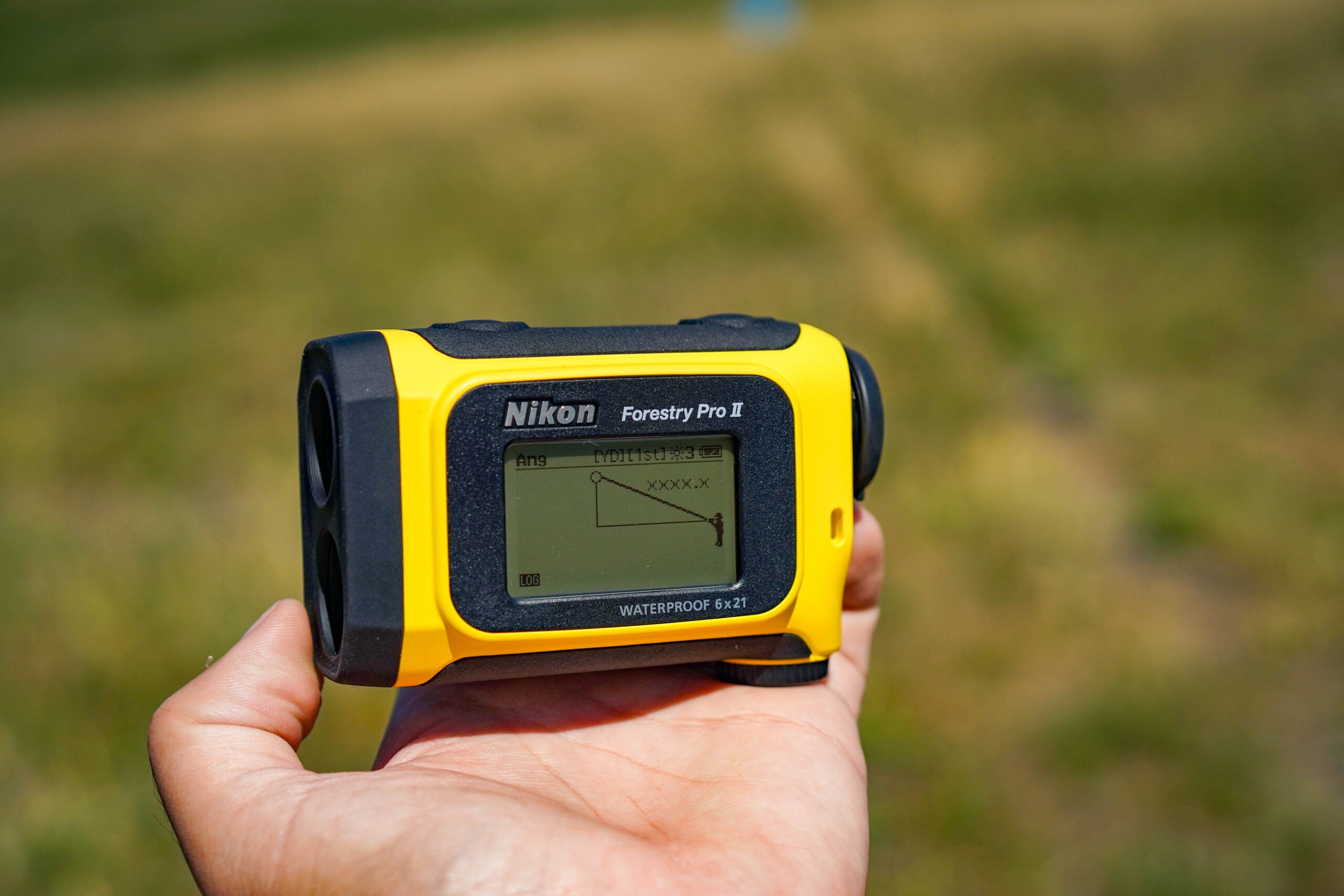
The Forestry Pro II has an external display that graphs each measurement, and it also has computational memory to store up to 250 measurements, so you can take and store angular measurements of a whole farm’s worth of stands.
Beyond the task-specific capabilities, this is a fast, precise, and competent rangefinder for most hunting chores. It delivers line-of-sight ranges and angle-compensated distance, and has both first and last target modes. Its display is a crisp black liquid crystal.
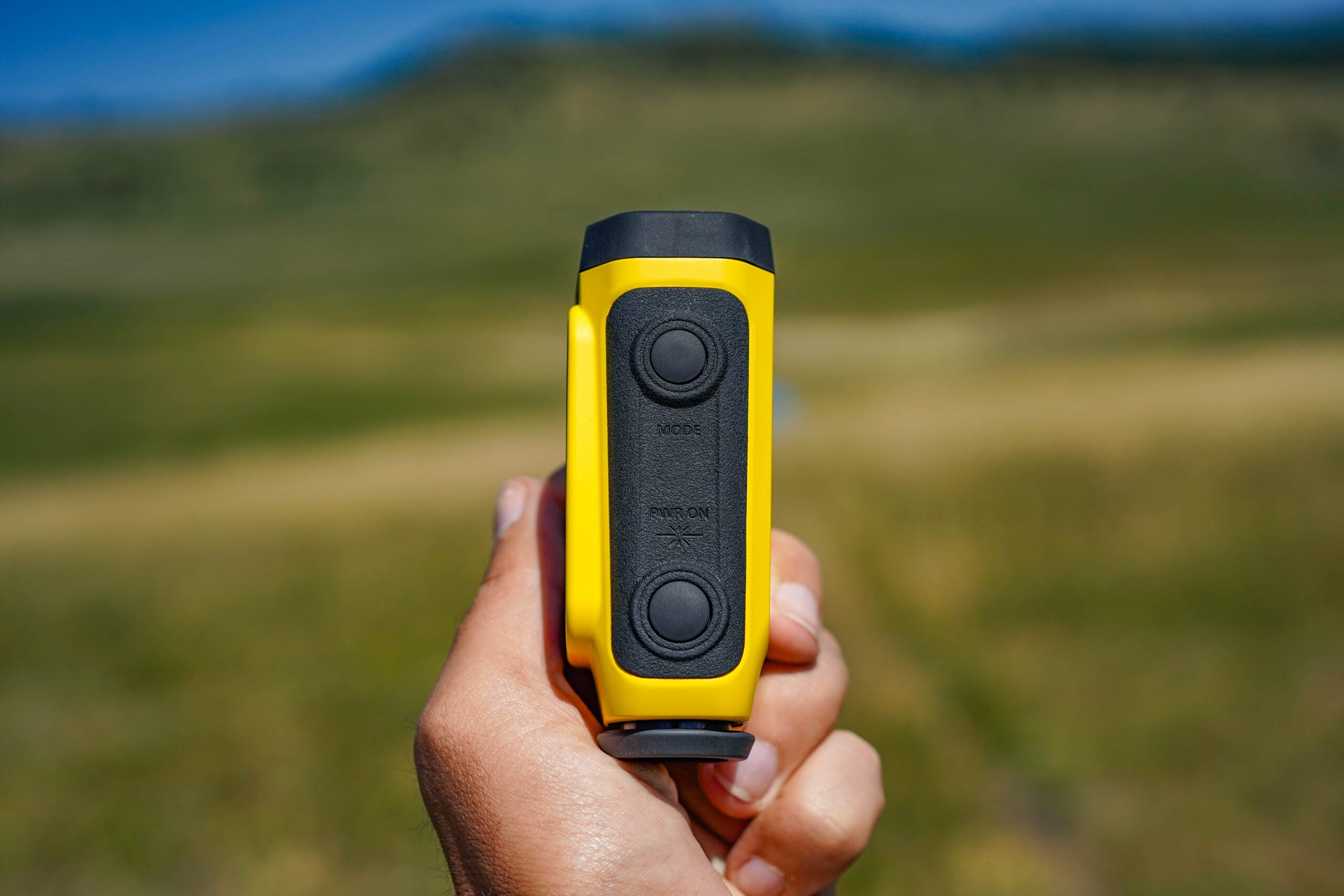
At about $450, this isn’t the cheapest monocular on the market, and, because it doesn’t have on-board or Bluetooth-able ballistics calculators, it’s unlikely to appeal to hardcore shooters. As the test team batted around notions of its perfect application, a couple rose to the front.
“Picking a treestand spot? It’s maybe the perfect tool for measuring height and angles,” noted tester Todd Netto.
“I could see this being the go-to choice for known-distance 3D/field archery competitions or for treestand hunters who want ultimate accuracy,” added Einsmann.
Read Next: Best Binocular Harnesses
Best Crossbow Rangefinder: Ravin 1200
Ravin
core Card
- Ranging Performance: Good
- Display/Optics: Fair
- Features: Good
- Price/Value: Good
Key Features
- 6x26mm
- Height and angle modes
- Line-of-sight, angle-compensating, and scan modes
- Backlit LCD display
- 1,200-yard ranging capability
Pros
- Very positive ranging button
- Display adjusts for light conditions
- Precise reticle
Cons
- No mobile-app connectivity
- Disappointing close ranging
Brand new for this year, the crossbow juggernaut Ravin has a rangefinder that’s almost as impressive as its bows. The 1200 is well-configured for use with a crossbow, in that its sweet spot is between about 25 and 125 yards. Within those parameters, testers found the unit to be precise, consistent, and responsive. Outside that distance, you get a good and fast range, but little else.
That assessment gets at what the Ravin 1200 lacks, which is connectivity to a mobile app or a galaxy of ballistic information. That’s to be expected, as most of what a crossbow shooter needs is a solid range inside the lethal capability of the bow, which is inside about 100 yards. Any ballistic solving can generally be done with the BDC references in the crossbow scope.
But don’t dismiss this rangefinder as a generic also-ran. It features one of the best triggers in our test, and we love the four-way pencil-point reticle that provides a fast and precise aiming point. The ranging engine is fast and responsive. We managed to get readings on non-reflective targets out to 1,310 yards, and while the close-in ranging was inconsistent, we got readings at about 13 yards. It has all the basics you’d expect: line-of-sight, angle-compensating, and scan modes along with a height and angle capability.
The price—just inside $400—is consistent with the performance of the 1200. It’s a handsome accessory for a Ravin crossbow, but it’s also a worthy rangefinder for just about any shooting and hunting within modest distances.
Read Next: Best Crossbows
Vortex Razor HD 4000 GB
Score Card
- Ranging Performance: Very Good
- Display/Optics: Very Good
- Features: Very Good
- Price/Value: Very Good
Key Features
- 4,000 yard stated range
- Loaded with GeoBallistics software
- On-board compass, environmental sensors
- 7x25mm
- Pairs with Kestrel units
- Magnesium chassis
- Applies wind modes to aiming solution
Pros
- Ships with premium case and lanyard
- Two wind modes
- Excellent long-range rangefinder
- Excellent glass and coatings
- Tripod mountable
- Best unit in test at ranging non-reflective targets
- Excellent co-witness unit for competitive shoots
- Toggles from long-range rifle unit to archery unit
Cons
- At nearly $1,200 MSRP, it’s a pricey unit
- On-board ballistics library is limited
- Maximum range was 2,800 yards
- Very girthy unit; won’t fit some hands
Vortex’s flagship rangefinding monocular, the Razor 4000 GB is optimized for long-range shooters, but it’s a great choice for rifle and archery hunters, too.
More on the Razor’s rangefinding attributes in a second, but the heart of the unit is the GeoBallistics solver with a full bullet database linked via Bluetooth. Think of this as Vortex’s equivalent to Sig’s Applied Ballistics database. Both provide a full range of customized aiming solutions, but the Vortex adds a couple of wind-based adjustments that give it an edge for long-range applications. Like the KILO4K, the Vortex informs aiming solutions with an on-board compass, humidity, temperature, and air pressure readings, and if you’re not happy with the data, you can easily connect an external Kestrel device to the Razor HD 4000.
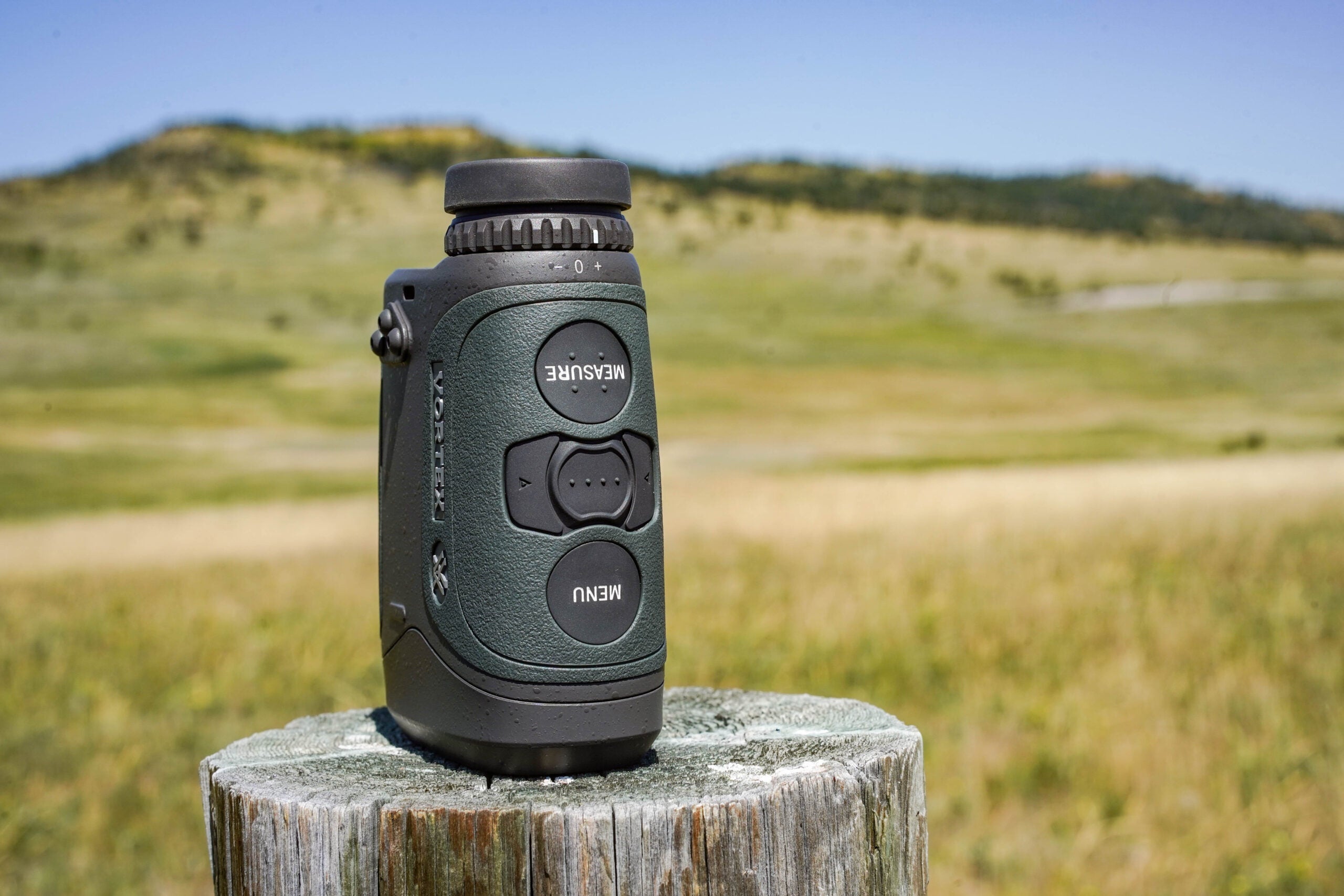
Ranging performance was mixed. During our test, we got readings only out to about 2,400 yards on non-reflective targets (far below the stated range of 4,000 yards on reflective targets), though we also recorded very satisfying 4.5-yard close readings, which makes this an excellent choice for archers. Return speed was among the best in our test, and right behind the Sig’s blazing-fast ranging engine. We liked the image brightness, and the red OLED display is fully adjustable to ambient light intensity.
We love the ballistic nylon case and lanyard that ships with the Vortex, but we also noted that the unit is one of the girthiest in our test, and is hard to hold and activate for users with smaller hands.
While savvy shoppers can probably pick up the Razor HD 4000 GB for close to $800, it retails for nearly $1,200, which is a steep price for a powerful unit that can do a little bit of everything but costs easily $200 more than the equally versatile—and image-stabilized—Sig.
Sig Sauer KILO3K
Score Card
- Ranging Performance: Excellent
- Display/Optics: Good
- Features: Good
- Price/Value: Very Good
Key Features
- On-board Applied Ballistics Ultralite
- Archery mode
- Onboard environmental sensors
- 6x22mm
- Bluetooth connection to BDX devices
- Compatible with BaseMap waypoints
Pros
- Includes most of Sig’s proprietary software
- Appealing price
- Target modes: first, best, last, fog, extended range
- Ranging modes include angle-compensating and archery settings
Cons
- Murky optics
- Intermittent power interruption
For the shooter and hunter who wants to access Sig’s remarkable galaxy of rangefinding technology, this is an excellent portal. In fact, if the Leupold RX-1400i hadn’t been in our test, the KILO3K would certainly have been our Great Buy recipient. It brings so many features to the game for about $360 that it needs to be in every conversation about capable price-point laser rangefinders.
The KILO3K brings nearly all the features that we applauded in the KILO4K, with the notable exception of image stabilization. The KILO3K connects via Bluetooth to Sig’s BDX ecosystem, which not only tethers to a mobile app that provides custom ballistic solutions, but also connects to BDX riflescopes. Through the app, the KILO3K can run Applied Ballistics’ External, which considers custom aiming solutions and location-specific wind and environmental factors to deliver a hyper-precise firing prescription.
If you don’t want to connect to an external device, the unit runs on Applied Ballistics Ultralite, which provides excellent distance-informed holds out to 800 yards. The Sig shows holds in MOA or MILs.
In our test, we confirmed close-in ranging of 6 yards, and while we struggled to get out to 3,000 yards, as the unit is advertised to range, we managed 2,660 on non-reflective targets. The laser processor is fast, precise, and consistent. We appreciated the auto-dimming mode for the red OLED display. This device is eligible for a free firmware update to install Sig’s Archery Mode, which considers your own arrow speed and incline. We didn’t test this particular feature.
We did detect some shortcomings. In our fairly rigorous testing, in which we traded each monocular among testers for several hours, the battery in the KILO3K faded repeatedly. We replaced the battery with a freshie, but noted that it drained power more quickly than its peers. The only other shortcoming we might note is that its ranging capability is limited to about 2,500 yards, but that’s hardly a shortcoming, as every yard inside that limit is informed by very specific ballistic inputs.
In short, this is an excellent choice for a shooter and hunter who dabbles in long-range target work but who mostly wants a solid rangefinder for real-world rifle and archery hunting situations.
Maven CRF.1
Score Card
- Ranging Performance: Good
- Display/Optics: Good
- Features: Good
- Price/Value: Good
Key Features
- 6x22mm
- Auto-bright red LED display
- Three selectable reticles
- Field and forest modes
Pros
- Display changes colors with ambient light
- Line-of-sight and angle-compensating modes
- Distinctive charcoal-and-orange accents
- Very appealing price
Cons
- No connectivity to mobile app
- No ballistics-informed ranging
- Not tripod mountable
Along with the Leupold 1400i and the Sig KILO3K, this Maven is a contender for our Great Buy award for delivering awesome value for the price. In the case of the Maven, you get a solid, capable mid-distance hunting and shooting rangefinder for a very affordable price of $250.
Before we talk about its attributes, let’s look at what you give up. You don’t have Bluetooth connectivity to other devices, including a mobile app that can supply custom ballistics solutions. You don’t have on-board ballistics data, either. Neither do you have temperature, barometric pressure, or geo-location sensors.
In terms of ranging performance, we struggled to range targets out to its stated capacity of 2,400 yards. Instead, we got our best and most consistent returns on non-reflective targets inside 1,500 yards. The minimum range of 5 yards was right on, as advertised.
“It’s a solid rangefinder for moderate distances, but it’s not as useful for hunting past about 600 yards, which is okay for most people but well under its stated range,” noted Einsmann. “But it performs the basic functions I need in a hunting LRF.”
If you don’t get extreme-distance heroics, you get an honest, reliable, and extremely responsive laser rangefinder that can deliver line-of-sight ranges or angle-adjusted readings. It has a very good scan mode. And you can toggle between any of three reticles, each of which delivers a different level of aiming resolution. The CRF.1 also has two ranging modes. Use Field Mode for open terrain and for ranging unobstructed targets. Or switch to Forest Mode for last-target situations where you want to filter out limbs, grass, and other obstructions.
We liked the LCD display that burns crisp black in daylight brightness or dims to a dull red in low-light conditions. The quick-access menu is another plus, enabling users to switch modes without scrolling through tedious menu options. In short, it’s a very utilitarian workhorse of a LRF for a very fair price.
Burris Signature LRF 2000
Score Card
- Ranging Performance: Good
- Display/Optics: Fair
- Features: Fair
- Price/Value: Fair
Key Features
- 7x25mm
- Auto, Sport, and Hunt modes
- Line-of-sight and angle modes
- Multiple-mode display options
Pros
- Intuitive use modes
- Nice close-distance ranging
- Red OLED display
Cons
- No connectivity to external devices
- Very basic LRF
- Not tripod mountable
The first laser rangefinding monocular from Burris, the Signature LRF 2000 is a very good freshman effort. It provides consistent ranges without a whole lot of fanfare from about 6 yards out to about 1,500 yards. What more could a hunter or shooter want?
The Burris’s performance is boosted by a very clean and stark red OLED display that isn’t cluttered with holdover or environmental information. We struggled to achieve the stated range of 2,400 yards, but did manage to range non-reflective targets out to about 1,800 yards, which is well within the operating envelope of the unit. Coming in close, we managed to get ranges inside 7 yards, a capability that should appeal to bowhunters.
The Burris doesn’t have Bluetooth connectivity to supporting ballistic apps, and neither does it have an on-board ballistic library. That means you’ll have to bring your own dope to the game, but the Signature 2000 provides three different ranging modes. Auto mode provides the strongest signal for target acquisition. Sport mode selects for the closest target in a tight group. And Hunt mode selects for the farthest target in a tight group, which is useful for ranging through branches, grass, and other obstructions. The display can provide five combined ranging options so shooters and hunters get precise readings for a wide variety of shooting and hunting situations.
Retailing for just over $350, this is a fairly priced rangefinder that might not wow you with a library of ranging options, but it will give you simple, reliable service for a fair price.
How to Choose a Laser Rangefinder

As you can deduce from the wide variety of capabilities in submission to this year’s LRF test, you can spend over $1,000 for a gee-whiz rangefinder, or you can spend $200 for a basic unit that will range your target even if it doesn’t make you breakfast.
It’s up to you to determine what you want out of a rangefinding monocular. Do you want a hand-held ballistic calculator that will give you precise ranging out to 2 miles for your pet load? Or are you satisfied with a basic unit that provides line-of-sight and angle-adjusted ranging and little else?
Of course, there are plenty of units that reside between those two poles, but the biggest differentiator for LRFs in this year’s test are those that borrow from a mobile app to provide very specific customized aiming solutions, and those that don’t allow for many inputs and instead spit out ranges for a few basic hunting and shooting scenarios.
The price between those two capabilities is immense, with Bluetooth-connected units selling for close to $1,000 and bare-bones LRFs retailing for under $300.
Beyond those basics, if you are mainly a bowhunter who wants archery-specific ranging data, look for those units that have arrow-flight dynamics baked into their software. Similarly, suppose you’re an ultra-long-distance target shooter. In that case, you’re going to want a unit with precise, situation-informed ranging results based around the specific bullet dynamics you’ve measured and plugged into the ranging software.
Check out the display of a rangefinder you’re interested in in a wide variety of light conditions. Some units have blazingly bright OLED displays while others have black LCD displays that can get lost against a cluttered background or low-light situations.
Lastly, consider the warranty. Unlike the lifetime, fully transferable warranty that has become an industry standard for non-electronic optics like binoculars and rifle scopes, most companies offer a limited warranty for electronics like rangefinders. But there’s such a wide range of protection on the market that it pays to take a close look at the details.
Final Thoughts on the Best Rangefinders
Most of us use only a single laser rangefinder button—the ranging button—and as long as we get fast, reliable range dope, we’re happy. That’s actually how we started our assessment, simply by punching the range button and recording the results.
But the cool thing about the new crop of laser rangefinding monoculars is that they are so adaptive. The most sophisticated have on-board or off-board ballistics solvers that can guide a bullet well beyond reasonable ranges. The best units have environmental sensors and sensitive angle and directional intelligence that can inform a shot whether you’re connected to your phone, or not. And the expectation of a LRF these days is that it must have both line-of-sight and angle-adjusted ranging along with ballistically informed ranging.
If you don’t need the full-on connected unit, make sure the unconnected unit performs the basics well, with an intensity adjusted display, an ergonomic body, and enough features to enable ranging a buck deer standing behind a screen of branches. The only downside to this crop of capable rangefinders is that they’re removing our last excuse for missing that must-hit shot.
The post The Best Rangefinders for Hunting of 2023 appeared first on Outdoor Life.
Articles may contain affiliate links which enable us to share in the revenue of any purchases made.
Source: https://www.outdoorlife.com/gear/best-rangefinders-for-hunting/


